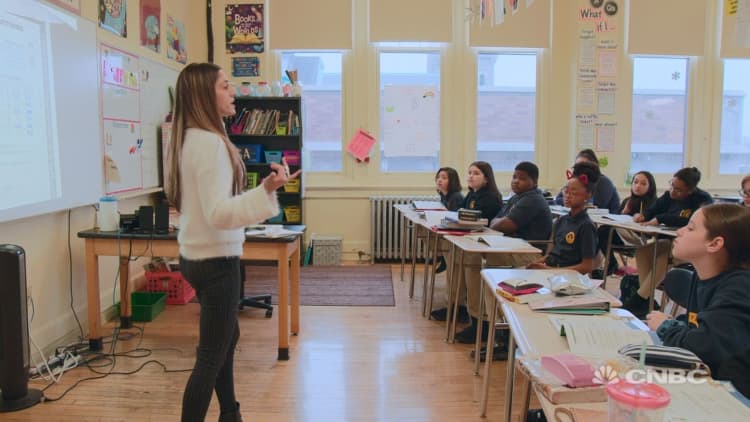
When it comes to the value of a dollar, most kids are at a loss.
The sixth graders at Golden Door, a public charter school in Jersey City, New Jersey, are trying to change that.
Starting in the fall, these 11- and 12-year-olds will be required by state law to learn the basics of saving and spending, the dangers of credit card debt and how to think about major expenses down the road, like a car or college
"I teach them a term called paying yourself first," said Danielle Traina, who already teaches financial literacy as part of the curriculum at Golden Door.
When you get paid, whether from chores, allowance, babysitting or a summer job, save a small amount for yourself and put it away immediately, she said, because otherwise, it quickly disappears. "Before you know it all that allowance is gone."
New Jersey schools have had have some financial education standards in place for several years, and a new law that goes into effect in September is taking those efforts a step further — requiring all school districts to teach financial literacy in sixth, seventh and eighth grades.
More commonly, some sort of financial education is taught in high school, but not across the board.
Only 17 states require high school students to take a class in personal finance — a number that hasn't budged in the past four years, according to the 2018 Survey of the States: Economic and Personal Finance Education in Our Nation's Schools.
About 28 states have some financial education standards in lower grades, including middle school, according to a recent report by the Brookings Institution. Yet advocates for early financial education say it's essential to start teaching at a younger age so kids will be able to better manage their money as adults.
"The sooner we teach our children about the value of money the better."Angela McKnightNew Jersey assemblywoman
"The sooner we teach our children about the value of money the better," said New Jersey Democratic assemblywoman Angela McKnight, who co-sponsored the bill that is now law.
About 1 in 5 children in the U.S. don't meet baseline levels for financial literacy proficiency, according to the often-cited PISA 2015 Financial Literacy assessment. Only 10 percent are considered "top performers" capable of analyzing complex financial products and problems.
Perhaps not surprisingly, students who are required to take personal finance courses have better average credit scores and lower debt delinquency rates as young adults, according to data from the Financial Industry Regulatory Authority's Investor Education Foundation, which seeks to promote financial education.
In addition, research shows that teenage financial literacy is positively correlated with asset accumulation and net worth by age 25, Brookings said.
Disclosure: NBCUniversal and Comcast Ventures are investors in Acorns.







